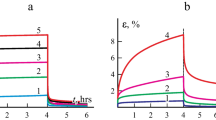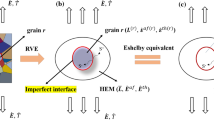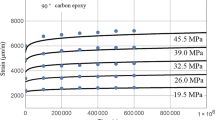Summary
A constitutive model is proposed to describe creep deformation of polycrystalline materials under complex stress and temperature histories. The concept of piecewise linear effective stress—creep strain rate relationship is utilized. A key assumption in this model is that the back stress under a given stress and temperature reaches a saturation point. This saturation point corresponds to the steady state condition.
Similar content being viewed by others
References
Besseling, J. F.: A theory of elastic plastic and creep deformation of an initially isotropic material showing anisotropic strain hardening, creep, recovery and secondary creep. J. Appl. Mech.25, 529–536 (1953).
Bodner, S. R., Merzer, A.: Viscoplastic constitutive equations for copper with strain history and temperature effects. ASME J. Engng. Mat. Techn.100, 388–394 (1978).
Cernocky, E. P., Krempl, E.: A theory of thermoviscoplasticity based on infinitesimal total strain. Int. J. Solids and Structures16, 723–741 (1980).
Chaboche, J. L.: Viscoelastic constitutive equations for the description of cyclic and anisotropic behavior of metals. Bull. Acad. Polon. Sci., Ser. Sci. Tech.25, 33 (1977).
Chaboche, J. L., Dang Van, K., Cordier, G.: Modelization of the strain memory effect on the cyclic hardening of 316 stainless steel. Trans. 5th Int. Conf. Struc. Mech. Reactor Tech. (Jaeger, T. A., Boley, B. A., eds.), Amsterdam: North-Holland 1979.
Faruque, M. O.: On the description of cyclic creep and rate dependent plastic deformation. Acta Mechanica55, 123–136 (1985).
Findley, W. N., Lai, J. S.: Creep and recovery of 2618 aluminum alloy under combined stress with a representation by a viscous-viscoelastic model. J. Appl. Mech.45, 507–514 (1978).
Garafalo, F.: Fundamentals of creep and creep-rupture in metals. New York: Macmillan 1965.
Gittus, J. H.: Dislocation creep under cyclic stressing: physical model and theoretical equations. Acta Met.26, 305–317 (1978).
Hart, E. W.: Constitutive relations for the nonelastic deformation of metals. Trans. ASME, J. Engr. Mat. and Tech.98, 193–202 (1976).
Kocks, U. F.: Laws for work-hardening and low-temperature creep. Trans. ASME, J. Engng. Mat. Tech.98, 76–85 (1976).
Krans, H.: Creep analysis. New York: Wiley 1980.
Krempl, E.: Cyclic creep—an interpretive literature survey. Welding Research Council. WRC Bull.195, 63 (1974).
Krieg, R. D.: Numerical integration of some new unified plasticity-creep formulations. Proc. 4th International Conference on Structural Mechanics in Reactor Technology, 1977.
Krieg, R. D., Swearengen, J. C., Rhode, R. W.: A physically-based internal variable model for rate-dependent plasticity, in: Inelastic behavior of pressure vessel and piping components (Chang, T. Y., Krempl, E., eds.), pp. 15–28, New York: ASME 1978.
Kujawski, D., Mroz, Z.: A viscoplastic material model and its application to cyclic loading. Acta Mechanica36, 213–230 (1980).
Laften, J. H., Stouffer, D. C.: An analysis of high temperature metal creep: Part II—A constitutive formulation and verification. Trans. ASME, J. Engng. Mat. Techn.100, 363–380 (1978).
Lagneborg, R.: A theoretical approach to creep deformation during intermittent load. ASME J. Basic Engng.93, 205 (1971).
Lagneborg, R.: A modified recovery-creep model and its evaluation. Met. Sci. J.6, 127–133 (1972).
Lagneborg, R.: Creep: mechanisms and theories, in: Creep and fatigue in high temperature alloys (Bressers, J., ed.), Applied Science publishers 1981.
Larsson, B., Storakes, B.: A state variable interpretation of some rate-dependent inelastic properties of steel. ASME J. Engng. Mat. Techn.100, 395–401 (1978).
Leckie, F. A., Ponter, A. R. S.: On the state variable description of creeping materials. Ing. Archiv.43, 158–167 (1974).
Malinin, N. N., Khadjinsky, G. M.: Theory of creep with anisotropic hardening. Int. J. Mech. Sci.14, 235–246 (1972).
Miller, A.: An inelastic constitutive model for monotonic, cyclic and creep deformation. ASME J. Engng. Mat. Tech.98, 97–113 (1976).
Mroz, Z.: On generalized kinematic hardening rule with memory of maximal prestress. J. Mech. Appl.5, 241–260 (1981).
Mroz, Z., Trampczynski, W. A.: On the creep-hardening rule for metals with a memory of maximal prestress. Int. J. Solids and Structures20, 467–486 (1984).
Murakami, S., Ohno, N.: A constitutive equation of creep based on the concept of a creep-hardening surface. Int. J. Solids and Structures18, 597–609 (1982).
Odqvist, F. K. G.: Mathematical theory of creep and creep rupture. Oxford University Press 1974.
Ohashi, Y., Ohno, N., Kawai, M.: Evaluation of creep constitutive equations for type 304 stainless steel under repeated multiaxial loading. ASME J. Engng. Mat. Tech.104, 159–164 (1982).
Ohnami, M., Motoie, K., Yoshida, N.: Study on the influence of strain history on creep of polycrystalline metallic materials at elevated temperature. Zairyo18, 226 (1969).
Ostrom, P., Lagneborg, R.: A recovery-thermal glide creep model. Trans. ASME, J. Engng. Mat. Tech.98, 114–124 (1976).
Paslay, P. R., Wells, C. H.: Uniaxial creep behavior of metals under cyclic temperature and stress or strain variation. J. Appl. Mech.98, 445–449 (1976).
Ponter, A. R. S., Leckie, F. A.: Constitutive relationships for the time-dependent deformation of metals. J. Engng. Mat. Techn.98, 47–51 (1976).
Rabotonov, Y. N.: Creep problems of structural members. Amsterdam: North-Holland 1969.
Robinson, D. N., Pugh, C. E., Corum, J. M.: Constitutive equations for describing high-temperature inelastic behavior of structural alloys. IAEA Int. Working group on fast reactors specialists—Meeting on high temperature structural design technology, 1976.
Robinson, D. N.: A unified creep-plasticity model for structural metals at high temperature. ORNL/TM-5969, Oak Ridge National Laboratory, 1978.
Swearengen, J. C., Rhode, R. W., Hicks, D. L.: Mechanical state relations for inelastic deformation on iron: the choice of variables. Acta Met.24, 969–975 (1976).
Swearengen, J. C., Rhode, R. W.: Application of mechanical state relations at low and high homologous temperatures. Met. Trans.8 A, 577–582 (1977).
Author information
Authors and Affiliations
Additional information
With 12 Figures
Rights and permissions
About this article
Cite this article
Faruque, M.O., Zaman, M.M. On modelling steady state and transient creep of polycrystalline solids. Acta Mechanica 71, 115–136 (1988). https://doi.org/10.1007/BF01173941
Received:
Revised:
Issue Date:
DOI: https://doi.org/10.1007/BF01173941




